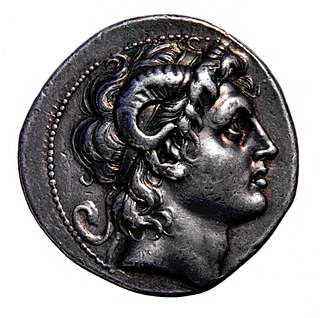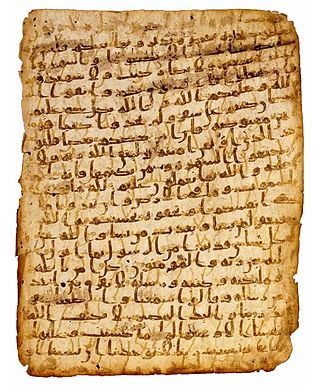
The Quran, also romanized Qur'an or Koran, is the central religious text of Islam, believed by Muslims to be a revelation from God. It is organized in 114 chapters, which consist of verses. In addition to its religious significance, it is widely regarded as the finest work in Arabic literature, and has significantly influenced the Arabic language.

Ibn Warraq is the pen name of an anonymous author critical of Islam. He is the founder of the Institute for the Secularisation of Islamic Society and used to be a senior research fellow at the Center for Inquiry, focusing on Quranic criticism. Warraq is the vice-president of the World Encounter Institute.
John Edward Wansbrough was an American historian who taught at the University of London's School of Oriental and African Studies (SOAS), where he was vice chancellor from 1985 to 1992.

Magog is the second of the seven sons of Japheth mentioned in the Table of Nations in Genesis 10.
Injil is the Arabic name for the Gospel of Jesus (Isa).
This Injil is described by the Quran as one of the four Islamic holy books which was revealed by God, the others being the Zabur, the Tawrat, and the Quran itself.

The story of Dhu al-Qarnayn, is mentioned in Surah al-Kahf of the Quran.

Al-Khidr is a figure described but not mentioned by name in the Quran as a righteous servant of God possessing great wisdom or mystic knowledge. In various Islamic and non-Islamic traditions, Khidr is described as an angel, prophet, or wali, who guards the sea, teaches secret knowledge and aids those in distress. He prominently figures as patron of the Islamic saint ibn Arabi. The figure of al-Khidr has been syncretized over time with various other figures including Dūraoša and Sorūsh in Iran, Sargis the General and Saint George in Asia Minor and the Levant, Samael in Judaism, Elijah among the Druze, John the Baptist in Armenia, and Jhulelal in Sindh and Punjab in South Asia. He is commemorated on the holiday of Hıdırellez.

Dhu al-Qarnayn, appears in the Quran, Surah Al-Kahf (18), Ayahs 83–101 as one who travels to east and west and sets up a barrier between a certain people and Ya'juj and Ma'juj. Elsewhere the Quran tells how the end of the world will be signaled by the release of Gog and Magog from behind the barrier. Other apocalyptic writings predict that their destruction by God in a single night will usher in the Day of Resurrection.
Gerd Rüdiger Puin is a German scholar of Oriental studies, specializing in Quranic palaeography, Arabic calligraphy and orthography. He was a lecturer of Arabic language and literature at Saarland University in Saarbrücken, Germany. In regards to his approach of historical research, Puin is considered a representative of the "Saarbrücken School", which is part of the Revisionist School of Islamic Studies.
History of the Quran is the timeline and origin of the written compilations or manuscripts of the holy book of Islam, based on historical findings. It spans several centuries, and forms an important major part of the early history of Islam.
In Islam, Qirāʼah are different linguistic, lexical, phonetic, morphological and syntactical forms permitted with reciting the holy book of Islam, the Quran. Differences between Qiraʼat are slight and include varying rules regarding the prolongation, intonation, and pronunciation of words, but also differences in stops, vowels, consonants, and less frequently entire words. Qiraʼat also refers to the branch of Islamic studies that deals with these modes of recitation.
In Christianity, the doctrine of the Trinity states that God is a single essence who exists, consubstantially and co-eternally, as a perichoresis of three distinct hypostases ("persons"): the Father, the Son, and the Holy Spirit. Islam considers the concept of any "plurality" within God to be a denial of monotheism and foreign to the revelation found in Muslim scripture. Shirk, the act of ascribing partners to God – whether they be sons, daughters, or other partners – is considered to be a form of unbelief in Islam. The Quran repeatedly and firmly asserts God's absolute oneness, thus ruling out the possibility of another being sharing his sovereignty or nature. In Islam, the Holy Spirit is believed to be the Angel Gabriel. Muslims have explicitly rejected Christian doctrines of the Trinity from an early date.

The Syro-Aramaic Reading of the Koran: A Contribution to the Decoding of the Language of the Koran is an English-language edition (2007) of Die syro-aramäische Lesart des Koran: Ein Beitrag zur Entschlüsselung der Koransprache (2000) by Christoph Luxenberg.
Criticism of the Quran is an interdisciplinary field of study concerning the factual accuracy of the claims and the moral tenability of the commands made in the Quran, the holy book of Islam. The Quran is viewed to be the scriptural foundation of Islam and is believed by Muslims to have been sent down by God (Allah) and revealed to Muhammad by the archangel Jabreel, also spelt Jibraeel (Gabriel). It has been subject to criticism both in the sense of being studied by mostly secular Western scholars and in being found fault with.
Günter Lüling was a German Protestant theologian, philological scholar and pioneer in the study of early Islamic origins. From 1962 to 1965 he was the Director of the German Goethe-Institut in Aleppo, Syria.

Islamic holy books are certain religious scriptures that are viewed by Muslims as having valid divine significance, in that they were authored by God (Allah) through a variety of prophets and messengers, including those who predate the Quran. Among the group of religious texts considered to be valid revelations, the three that are mentioned by name in the Quran are the Tawrat, received by prophets and messengers amongst the Children of Israel; the Zabur (Psalms), received by David; and the Gospel, received by Jesus. Additionally, the Quran mentions God's revealing of the Scrolls of Abraham and the Scrolls of Moses.

The Ahmadiyya branch in Islam has relationships with a number of other religions. Ahmadiyya consider themselves to be Muslim, but are not regarded as Muslim by mainstream Islam. Mainstream Muslim branches refer to the Ahmadiyya branch by the religious slur Qadiani, and to their beliefs as Qadianism a name based on Qadian, the small town in India's Punjab region where the founder of Ahmadiyya, Mirza Ghulam Ahmad was born.

In Muslim tradition the Quran is the final revelation from God, Islam's divine text, delivered to the Islamic prophet Muhammad through the angel Jibril (Gabriel). Muhammad's revelations were said to have been recorded orally and in writing, through Muhammad and his followers up until his death in 632 CE. These revelations were then compiled by first caliph Abu Bakr and codified during the reign of the third caliph Uthman so that the standard codex edition of the Quran or Muṣḥaf was completed around 650 CE, according to Muslim scholars. This has been critiqued by some western scholarship, suggesting the Quran was canonized at a later date, based on the dating of classical Islamic narratives, i.e. hadiths, which were written 150–200 years after the death of Muhammad, and partly because of the textual variations present in the Sana'a manuscript. With the discovery of earlier manuscripts which conform to the Uthmanic standard however, the revisionist view has fallen out of favor and been described as "untenable", with western scholarship generally supporting the classical Muslim view.
The Revisionist school of Islamic studies, is a movement in Islamic studies that questions traditional Muslim narratives of Islam's origins.












